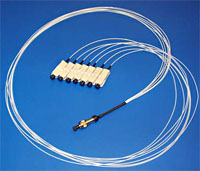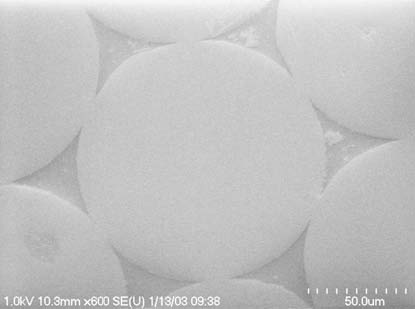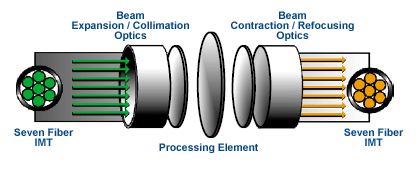HEPTOPORT™
 Dense Multi-Port Optical Component Solutions
Dense Multi-Port Optical Component SolutionsUsing Impact Mount™ Technology
Currently, in the telecom industry, technology is far ahead of the marketplace. Of the three design drivers - cost, performance, and reliability - cost heavily dominates the list. Market dynamics are pressuring manufacturers to produce fiber optic components at very low cost; but they cannot support the economy of scale that traditionally accompanies high volume manufacturing.
There is, however, still demand for performance and reliability at the right price. Important performance issues such as wavelength and port scalability, loss uniformity, and modularity can only be achieved through manufacturing innovation, whereby tight process control parameters produce the desired results. The emerging importance of manufacturing innovation to component and module performance represents a paradigm shift for the optical communications industry. Impact Mount™ Technology (IMT), and its progeny, HeptoPort™, typifies this paradigm shift. Multiple ADMs, DWDM selectors, isolators, interleavers, and many other functions can be incorporated in a single component, sharing the cost of expensive elements such as filters, lenses, etc.
For a single fiber operation, the result of IMT application is a hermetic mechanical fit of the fiber to the inside of the ferrule. The process satisfies Telcordia GR-488 environmental exposure requirements. Fibers with IMT ferrules maintain helium leak rates of 2.7x10-11 atm.-cc/s over 2000 thermal cycles of -40oC to 100oC. Pull-test results on the fiber pigtails exceeded the 1kg requirement and the fiber piston movement was typically less than 80nm. The ferrule is attached to the package via laser welding or solder processing.
The IMT process is well suited for machine automation. It is used in production of fiber pigtails for telecommunications applications. The fiber pigtail preparation may also be readily integrated with automated alignment and attachment stations when using IMT to attach the ferrule onto the fibers.
HeptoPort™ Technology
Experience with IMT has led to a new concept for affixing and terminating multiple fibers, with extraordinary self-alignment features. The mechanical compression in IMT is so uniform that it can be used to affix fiber bundles in hexagonal close-packed arrangements within a ferrule. The circular symmetry inherent to hexagonal close-packed fiber bundles lends itself naturally to the IMT method. IMT guides, in one instantaneous action, arrays of stripped optical fibers to their natural hexagonal close-packed arrangement, like marbles falling into a box. The alignment of the positions of the centers of the surrounding "planetary" fibers, relative to the center "sun" fiber, is determined entirely by the uncertainties in fiber outside diameter, circularity, and core/cladding concentricity. These uncertainties are less than 0.6 microns, worst case, for the seven-fiber HeptoPort™ configuration.
Figure 2 shows a scanning tunneling electron microscope photograph of the end face of an IMT ferrule mounted with seven ports. The ductile metal has surrounded the fiber bundle, and all seven fibers are in contact with each other. They have found their naturally preferred positions in the hexagonal close-packed configuration.

Figure 2. STEM photograph of a HeptoPort structure, showing self-alignment of the seven fibers

Figure 3. Diagram of the HeptoPort™ architecture, including seven-fiber IMT multi-port I/O, expanded beam optics, and processing element. Different processing elements can be incorporated into this architecture, resulting in different functions, without retooling
The HeptoPort™ concept is embodied in a physical architecture, shown in Figure 3. This architecture suggests a new genre of multi-port applications in the optical communications industry. The technology and its associated architecture are called HeptoPort™. Utilizing IMT and expanded beam optics as an integral part of the physical structure, it is possible to produce a variety of external functionalities by implementing different processing elements in the HeptoPort™ body. Two examples of this concept are WDM add-drop multiplexers and isolators.
Experience with IMT has led to a new concept for affixing and terminating multiple fibers, with extraordinary self-alignment features. The mechanical compression in IMT is so uniform that it can be used to affix fiber bundles in hexagonal close-packed arrangements within a ferrule. The circular symmetry inherent to hexagonal close-packed fiber bundles lends itself naturally to the IMT method. IMT guides, in one instantaneous action, arrays of stripped optical fibers to their natural hexagonal close-packed arrangement, like marbles falling into a box. The alignment of the positions of the centers of the surrounding "planetary" fibers, relative to the center "sun" fiber, is determined entirely by the uncertainties in fiber outside diameter, circularity, and core/cladding concentricity. These uncertainties are less than 0.6 microns, worst case, for the seven-fiber HeptoPort™ configuration.
Figure 2 shows a scanning tunneling electron microscope photograph of the end face of an IMT ferrule mounted with seven ports. The ductile metal has surrounded the fiber bundle, and all seven fibers are in contact with each other. They have found their naturally preferred positions in the hexagonal close-packed configuration.

Figure 2. STEM photograph of a HeptoPort structure, showing self-alignment of the seven fibers

Figure 3. Diagram of the HeptoPort™ architecture, including seven-fiber IMT multi-port I/O, expanded beam optics, and processing element. Different processing elements can be incorporated into this architecture, resulting in different functions, without retooling
The HeptoPort™ concept is embodied in a physical architecture, shown in Figure 3. This architecture suggests a new genre of multi-port applications in the optical communications industry. The technology and its associated architecture are called HeptoPort™. Utilizing IMT and expanded beam optics as an integral part of the physical structure, it is possible to produce a variety of external functionalities by implementing different processing elements in the HeptoPort™ body. Two examples of this concept are WDM add-drop multiplexers and isolators.

